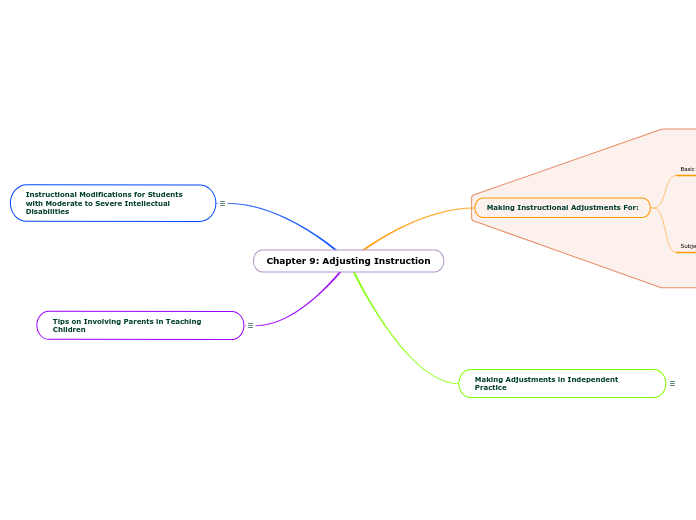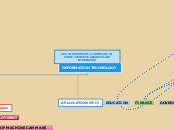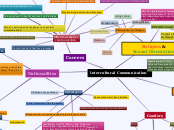Chapter 9: Adjusting Instruction
Tips on Involving Parents in Teaching Children
Parental involvement with students with disabilities is important because they often need help with homework at home and repetition of skills learned. Contacts with parents about homework can be increased through parent-teacher conferences, this can also be done through email. Involve the parents by creating checklists, newsletters, notes, phones calls, and/or discussion groups. Have parents teach the student skills and concepts that are on the students level. Limit the amount of time parents tutor to 15 min in grades up to six.
Instructional Modifications for Students with Moderate to Severe Intellectual Disabilities
Students with moderate to severe intellectual disabilities often times are unable to perform every day tasks that students without disabilities are able to. It is important we make modifications for these students so that they are able to meet the same curricular standards. One way to do this is by modifying materials and activities by conducting an environmental inventory. Also, make sure that modifications made match the students' IEP.
Making Adjustments in Independent Practice
It is often hard to meet the needs of all students when designing practice activities because every student has different needs. Listed below are adjustments that can be made to meet the needs of students with special needs.
Adjusting seatwork assignments:
- Verbally present the tasks. adjust directions or verbally read them out.
- Practice examples with the whole class and/or small group before assigning independent work.
- Write alternative sets of direction.
- Highlight the important words in directions.
- Use peer tutoring.
Adjusting homework assignments- Ask yourself these questions:
- What skill demands does the assignment require. Is the student capable of meeting these skills?
- What background knowledge does the assignment require? Does the student have the required background knowledge
- Does the assignment include lots of practice on few skills rather then little on a lot of skills?
- Is the purpose of the assignment clear to students?
- Are clear, written directions provided for how to complete the assignment?
- Is the student given enough time to complete the assignment?
Making Instructional Adjustments For:
Subject area content
4. Communicating Clearly
When ideas are clearly tied together this enables students to understand them more easily. Also, effective communication requires both oral (giving directions, asking questions, and delivering instruction) and written (textbooks, handouts, homework and written tests).
3. Teaching Terms
Students with disabilities or students who are at risk are likely to have difficulty with vocabulary and concept demands of content area texts.
- State definitions simply and clearly
- Ask questions to probe understanding of positive from negative examples.
- Ask open-ended questions to probe whether students can discriminate the new word from previously learned vocab.
2. Organizing content
Students can benefit from scaffolds and supports (graphic organizers, study guides, advance organizers, cue words and organizational patterns) that help them identify important information. Organize curriculum according to big ideas rather than facts in isolation.
1. Activating Background Knowledge
The amount of background knowledge a student has on a subject matter will greatly influence whether they can read with understanding. Just as preskills, you should check for students' background knowledge prior to teaching the lesson. Try to activate prior knowledge by having students make predictions.
Basic Skills:
4. Providing Direct Instruction, Practice and Review
Students at risk or have disabilities may need more direct instruction in order to learn skills. Consistent practice is needed in order for students to retain information and mastery of skills.
3. Introducing New Skills
INCLUDE strategy: teach one skill at a time. Introduce new skills in small steps at a rate slow enough to ensure mastery. Prioritize some skills such as foundational skills before moving on, if needed.
2. Selecting and Sequencing Examples
The example selection that you choose for instruction and student practice can help students learn to make distinctions between concepts more readily. Choose examples that first, require the use of only one skill. Once the skill is mastered, it is then appropriate to start adding examples of previous taught skills. Students will then be able to make a distinction between the different skills. Sequencing should follow an appropriate order. Try to stay away from introducing new concepts, such as man and men that look and sound the similar, too soon to each other. Let students master one before moving on to the next.
1. Teaching Preskills
These are basic skills that are needed to perform more complex skills. Prior to teaching, you should assess students on relevant preskills and teach them if needed. When teaching preskills, teach them directly before teaching the more complex skill. If only one or two students are lacking the preskill then you can accommodate them with extra practice and instruction.









